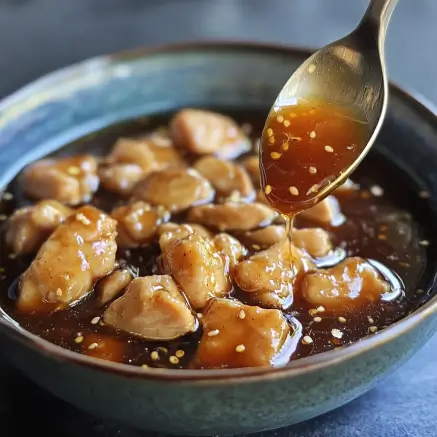Introduction to Honey Chicken Sauce
Honey chicken sauce is a deliciously versatile condiment that adds a unique twist to chicken dishes. It’s a blend of sweet, savory, and tangy flavors, creating a mouthwatering coating for crispy chicken. Popular in both home kitchens and restaurants, it’s prized for its ability to transform simple ingredients into something extraordinary.
But what is honey chicken sauce made of? The answer lies in its carefully selected ingredients that work together to create a harmonious balance of flavors. Understanding these elements allows you to appreciate the dish even more and perhaps even try creating it yourself.
The History and Origins of Honey Chicken Sauce

The origins of this sauce trace back to the fusion of Asian and Western culinary traditions. While the exact roots are debated, many credit Chinese cuisine for introducing the combination of honey, soy sauce, and aromatic spices. These flavors were traditionally used in stir-fries and marinades, showcasing the versatility of the ingredients.
As trade routes expanded, the idea of sweet-savory glazes spread to the West, where honey became a key component of barbecue and other sauces. Over time, chefs began experimenting with blending the sweetness of honey with salty, tangy, and spicy flavors, eventually crafting the sauce we know today. Its global popularity reflects how this fusion of traditions resonates with taste buds everywhere.
Why Honey Chicken Sauce is a Culinary Favorite
There’s a reason honey chicken sauce is a favorite among food lovers—it appeals to nearly every palate. Its complex flavor profile combines sweetness, saltiness, and acidity in perfect harmony, making it suitable for a wide range of dishes.
Some key reasons for its popularity include:
- Versatility: It pairs well with chicken, tofu, vegetables, and even seafood.
- Ease of preparation: The simple combination of common pantry ingredients makes it accessible to home cooks.
- Global appeal: Its roots in different cuisines make it adaptable to various cooking styles.
With these qualities, honey chicken sauce has become a staple in many kitchens. But to truly understand its allure,Let’s try what the sauce is made of and how each ingredient contributes to its flavor.
For those who enjoy unique twists on honey-based flavors, the KFC hot honey sauce is a must-try. It combines the sweetness of honey with bold spices, creating a distinct flavor profile loved by fast-food enthusiasts.
The Main Ingredients of Honey Chicken Sauce
What is honey chicken sauce made of? At its core, it’s a combination of simple yet powerful ingredients that create a dynamic flavor experience. These include:
- Honey: The star of the sauce, adding sweetness and a sticky texture.
- Soy sauce: A salty, umami-rich element that balances the sweetness.
- Garlic and ginger: Aromatic spices that provide depth and warmth.
- Vinegar: Adds acidity to cut through the richness.
- Cornstarch or flour: Helps thicken the sauce to coat chicken perfectly.
Each of these ingredients plays a critical role in building the flavor and texture of the sauce, ensuring it’s both satisfying and memorable.
For a more in-depth guide to pairing this sauce with different meals, examine what works best with hot honey tenders, including sides like rice, vegetables, or noodles.
How Honey Impacts the Flavor and Texture
Honey is the cornerstone of honey chicken sauce, and its role is multifaceted. Not only does it contribute natural sweetness, but it also lends a sticky, glossy finish that makes the sauce cling to the chicken. This texture is key to creating the dish’s signature appeal.
Moreover, honey’s complex sweetness has subtle floral and earthy notes, elevating the overall flavor profile. When heated, honey caramelizes, adding depth and a slight smokiness that complements the savory and tangy components of the sauce. Without honey, the sauce would lack its characteristic richness and body.
The Role of Soy Sauce in Honey Chicken Sauce
Soy sauce is another essential component, offering a salty and umami-rich contrast to the honey. Its fermented depth of flavor Assures that the sauce isn’t overwhelmingly sweet, providing a balance that keeps it versatile and enjoyable.
In addition to flavor, soy sauce improves the sauce’s color, giving it a rich, appetizing appearance. By blending effortlessly with honey, garlic, and ginger, soy sauce creates a well-rounded base that forms the foundation of the dish. Without it, the sauce would lose its savory balance, making it less appealing.
Using Garlic and Ginger for Depth of Flavor
Garlic and ginger are aromatic powerhouses in honey chicken sauce. They provide a spicy, earthy backbone that complements the sweet and salty elements.
- Garlic: Adds a robust, slightly pungent flavor that balances the sweetness of honey.
- Ginger: Contributes a warm, zesty kick that improves the sauce’s complexity.
These ingredients work in harmony, ensuring that the sauce has layers of flavor rather than being one-dimensional. Sautéing garlic and ginger before adding other ingredients helps release their oils, maximizing their impact.
To improve your cooking further, learn the difference between chicken tenders and chicken strips to choose the perfect protein for your recipe.
Balancing Sweetness with Vinegar and Acidity
No sauce is complete without balance, and in honey chicken sauce, vinegar plays a critical role. Adding a splash of vinegar, such as rice vinegar or apple cider vinegar, introduces a tangy acidity that cuts through the richness of the honey and soy sauce.
This balance Assures the sauce isn’t overly sweet or salty. Instead, the vinegar rounds out the flavors, making the sauce more dynamic and satisfying. By including an acidic component, the sauce appeals to a wider range of tastes, ensuring it’s both bold and harmonious.
By understanding what honey chicken sauce is made of and the role of each ingredient, you can appreciate why this dish has become a culinary favorite worldwide. Whether you’re making it at home or enjoying it at a restaurant, the thoughtful balance of flavors Assures it’s always a crowd-pleaser.
Thickening Agents: How Cornstarch Works Wonders
One essential element of honey chicken sauce is its perfect consistency, and cornstarch plays a critical role in achieving this. Acting as a thickening agent, cornstarch helps the sauce cling to chicken and other proteins, creating a rich, glossy coating.
When mixed with a liquid like water or soy sauce, cornstarch forms a slurry. This slurry is added to the heated sauce mixture, where it thickens as it cooks. The science behind this transformation lies in the starch molecules expanding when exposed to heat, resulting in a smooth and velvety texture. Without cornstarch, the sauce would be too runny, failing to deliver the signature sticky glaze that defines honey chicken sauce.
Different Variations of Honey Chicken Sauce
Honey chicken sauce is highly versatile, offering endless opportunities for customization. By altering the ingredients or proportions, you can create variations that suit different cuisines and preferences.
Some popular variations include:
- Spicy Honey Chicken Sauce: Add chili flakes or sriracha for a fiery kick.
- Lemon Honey Chicken Sauce: Replace vinegar with fresh lemon juice for a zesty twist.
- Asian-Inspired Honey Chicken Sauce: Incorporate sesame oil and a dash of hoisin sauce.
- Herb-Infused Honey Chicken Sauce: Mix in fresh herbs like cilantro or parsley for an aromatic flavor.
Experimenting with these variations allows you to adapt the sauce to your taste while keeping the core elements of sweetness, saltiness, and tanginess intact.
Step-by-Step Recipe for Honey Chicken Sauce
Making honey chicken sauce at home is straightforward and requires only a few ingredients. Here’s a simple step-by-step guide:
Ingredients:
- 1/3 cup honey
- 1/4 cup soy sauce
- 2 cloves garlic, minced
- 1 teaspoon fresh ginger, grated
- 2 tablespoons vinegar (rice or apple cider)
- 1 tablespoon cornstarch mixed with 2 tablespoons water (slurry)
Instructions:
- Sauté the aromatics: Heat a tablespoon of oil in a pan. Add garlic and ginger, stirring until fragrant.
- Mix the base ingredients: Pour in the honey, soy sauce, and vinegar, stirring to combine.
- Thicken the sauce: Gradually add the cornstarch slurry, stirring continuously until the sauce thickens.
- Simmer: Reduce the heat and let the sauce simmer for 2-3 minutes for the flavors to meld.
- Use immediately: Coat your cooked chicken or store for later use.
This recipe provides the foundation for a flavorful honey chicken sauce, but you can tweak it based on your preferences.
Pairing Honey Chicken Sauce with Proteins and Sides
Honey chicken sauce is, without question, incredibly versatile, pairing wonderfully with a wide variety of proteins and sides. Its sweet and savory profile not only improves the flavors of countless dishes but also makes it a go-to option for both casual meals and special occasions.
Best protein pairings:
- Chicken: This sauce works perfectly with fried, baked, or grilled chicken, adding a delightful layer of flavor to every bite.
- Pork: It also complements pork chops or ribs beautifully, creating a sweet-savory glaze that improves the dish.
- Seafood: For seafood lovers, honey chicken sauce adds a deliciously sweet-savory touch to shrimp or salmon, making it an excellent choice.
- Tofu: Additionally, it serves as a fantastic vegetarian option, as tofu soaks up the sauce beautifully, ensuring a flavorful experience.
Ideal side dishes:
- Rice: Pair it with steamed jasmine or fried rice, as both options absorb the flavorful sauce wonderfully, creating a satisfying base.
- Vegetables: Moreover, stir-fried broccoli, carrots, or snow peas are excellent choices, providing balance to the meal with their crisp texture.
- Noodles: Finally, toss the sauce with lo mein or ramen noodles, and you’ll have a dish that’s not only delicious but also comforting.
The adaptability of honey chicken sauce, without a doubt, makes it a favorite for diverse meal pairings, ensuring it complements almost any dish you choose to serve it with.
Tips for Customizing Honey Chicken Sauce to Your Taste
While honey chicken sauce is already flavorful, customizing it can make it even more enjoyable. Tweaking the ingredients allows you to create a version that aligns perfectly with your preferences.
Customization ideas:
- Increase sweetness: Add more honey for a sweeter glaze.
- Boost umami: Mix in a tablespoon of oyster sauce or miso paste.
- Add spice: Incorporate chili paste or fresh jalapeños for heat.
- Experiment with aromatics: Use shallots or lemongrass for a unique twist.
When adjusting the recipe, taste as you go to guarantee the flavors remain balanced. Customizing your sauce Assures it’s tailored to your taste, whether you prefer mild or bold flavors.
Storage and Shelf Life of Honey Chicken Sauce
Proper storage is essential to maintaining the freshness of honey chicken sauce. By following simple steps, you can extend its shelf life and Assure it remains safe to use.
Storage tips:
- Refrigeration: Store leftover sauce in an airtight container and refrigerate for up to one week.
- Freezing: For longer storage, freeze the sauce in small portions. Thaw and reheat as needed.
- Reheating: Gently warm the sauce on the stove or in the microwave, stirring to restore its consistency.
When stored correctly, honey chicken sauce retains its flavor and texture, allowing you to enjoy it in future meals.
FAQs
What is honey chicken sauce made of?
Honey chicken sauce is, without a doubt, a flavorful blend of sweet, savory, and tangy ingredients. To begin with, honey provides the natural sweetness that serves as the foundation of the sauce. Additionally, soy sauce is incorporated to introduce its salty and umami-rich profile, which, in turn, balances the sweetness beautifully. Furthermore, garlic and ginger are added, contributing aromatic depth and enhancing the overall complexity of flavors.
Moreover, vinegar plays a crucial role by cutting through the sweetness and adding a tangy kick. Lastly, cornstarch is used, not only to thicken the sauce but also to create a smooth, velvety texture that coats the chicken perfectly. Altogether, these ingredients work harmoniously to deliver a sauce that improves chicken dishes to a whole new level of deliciousness.
Does KFC have hot honey sauce?
Yes, KFC has offered hot honey-inspired sauces in the past, such as their Honey BBQ and Honey Garlic sauces. These sauces combine the sweetness of honey with a kick of heat or tanginess. Availability may vary by location and time, so it’s best to check with your local KFC or visit their website for the latest menu updates.
What to eat with hot honey tenders?
Hot honey tenders pair wonderfully with a variety of sides and accompaniments. Popular choices include white or brown rice, steamed or stir-fried vegetables like broccoli or carrots, crisp garden salads with light dressings, and breads such as cornbread or dinner rolls. For additional flavor, dipping sauces like ranch or blue cheese provide a cooling contrast to the spiciness.
What is the difference between chicken tenders and chicken strips?
Chicken tenders, also known as tenderloins, are specific muscles located beneath the chicken breast, prized for their tenderness. In contrast, chicken strips are slices of chicken breast meat that vary in size and texture. While both are boneless and versatile, tenders are generally more delicate, whereas strips can have a firmer bite.


2 thoughts on “What Is Honey Chicken Sauce Made Of? A Tasty Guide”